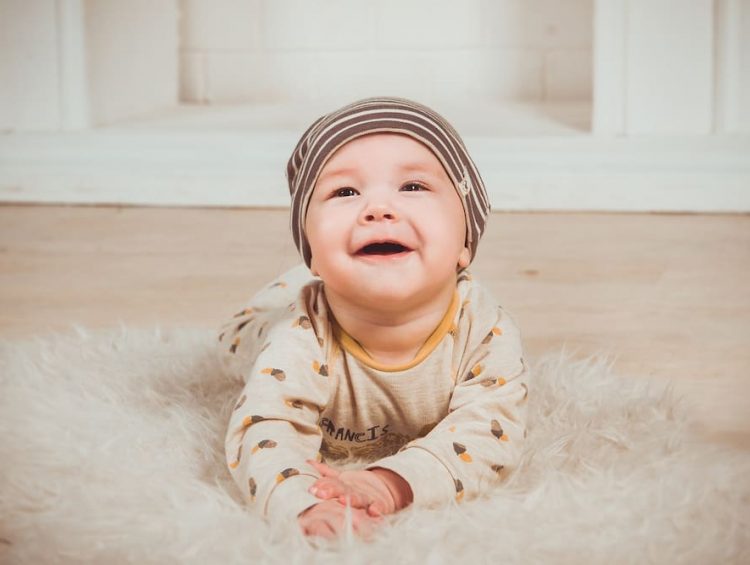One of the best things about welcoming a baby into the world and into your home is being able to look into their eyes and feel a connection right away. However, you might become discouraged and concerned if your child avoids eye contact. The development of a baby’s vision is crucial; in fact, it’s a crucial milestone that deepens the relationship between parents and infants. If you are the parents of a newborn, you probably wonder when your child will look at you and what you can do to encourage him.
We understand that you are anxious to find out when do babies make eye contact. So, here is the answer: Most babies, make their first direct eye contact during their first 6 to 8 weeks of age.
Please keep reading.
Table of Contents
Is Eye Contact Crucial For Young Children?
It’s crucial to establish eye contact for two reasons: emotional connection and brain development.
Early attachment and bonding with your baby depend on you two making eye contact. Your unique bond with your child enhances their sense of security and promotes healthy brain development. As a parent, you can support your child’s emotional development by being more attentive to and connected to your baby’s communication.
For more details, you might want to read Aware Parenting 101 with Lael Stone.
Your baby begins to associate emotions with facial expressions when they see your eyes and face (for example, “I feel happy”). a smile means happiness). They acquire the ability to react, engage with and relate to others, control their own emotions, and communicate.
As your child grows and gains the ability to follow your gaze, they will begin to communicate with you. Through play and communication, they are better able to learn new words and expand their vocabulary. When infants point to an object and their caregiver names it for them, this occurs.
Is It Typical For Infants To Avoid Eye Contact?
Young infants won’t always look you in the eyes. As your baby gets older, keep in mind that this is a developmental milestone that happens gradually.
Usually, when babies are engaged with their caregivers for play, security, or social reasons, they begin to make very deliberate eye contact.
But occasionally, infants simply grow weary and stop wanting to look at or concentrate on you. Some infants become overstimulated as a result of eye contact and the neural signals it receives! For a while afterward—possibly even for weeks—they may avoid eye contact. You will get to know your baby’s unique personality as well as the cues that indicate when they are eager to make eye contact.
When Should I Be Concerned About My Baby Looking At Me?
If you are concerned about your baby making eye contact, consult a pediatrician or member of your healthcare team. Some infants are born with vision impairment, while others acquire it as a result of an ailment, injury, or disease. This may affect their capacity for eye contact and serve as a red flag for potential problems.
Your child may receive a referral to a pediatric ophthalmologist from your general practitioner or pediatrician. In order to determine if there is a problem and how to address it, the ophthalmologist will perform some tests.
Eye Gaze Development In Infants
In infants, eye gaze development takes place as explained below:
- Within seven hours of birth, a baby typically begins to show a significant interest in their mother’s face. Additionally, they frequently mimic their mother’s or caregiver’s facial expressions.
- A baby begins to purposefully look at his mother or other caregiver during the first 6 to 8 weeks after birth.
- A baby can begin to mimic the mother’s or caregiver’s movements around the age of three months.
- By the time they are 9 to 11 months old, they have mastered the skill of following an adult’s actual eye gaze. At this point, they realize that the purpose of eyes, i.e., to look and see. Don’t worry if your baby is taking his time; some babies’ development may take a little longer.

How Can I Encourage My Infant To Look Me In The Eyes?
It’s a precious moment when you can look your baby in the eyes. You may be curious about when your baby will start looking into your eyes because every baby develops at their own rate. You can encourage your little one to make eye contact, with these tips:
- Wait until the infant is content, not hungry or tired, or not in the witching hour! When you’re both calm and happy, eye contact is more likely to happen
- Hold the infant close, particularly when feeding. This promotes intimacy and keeps you in their area of attention. Alternate sides as well, so your baby
- Take advantage of your baby’s eye contact by starting to talk, smile, or even sing. This encourages your baby to focus on you more and they will store these interactions and become integrated in future development
- Don’t look away before your baby does, hold their gaze for as long as they’re interested
- When they turn their heads away, be considerate that might be it for the time being because your baby might be tired or simply fed up. Don’t force more eye contact
- Eye contact is enhanced by touch or sound, when it is gentle and calm, to enhance the experience and bond
- Don’t expect newborns and young babies to maintain prolonged, intense eye contact because they are still learning how to do this.
- As your child grows, allow them to track and follow objects, and name them so they can remember them and develop their communication skills.
Activities That Can Help Infants Make Eye Contact
It is advised to take the infant to an optometrist to aid in the development of his eye contact. Baby must undergo his initial eye examination between the ages of 6 and 12 months. This is to ensure that the infant has no existing eye conditions, such as nearsightedness, astigmatism, or farsightedness., The infant must continue going to the doctor for routine eye exams until at least age 3 in case any problems are discovered (which is a rare occurrence).
Small activities can be carried out by the parent to help the baby improve his eye moments, which will improve his eye contact.
- Allow the infant to learn to reach out for objects he finds appealing during the first four months of life. This helps the baby develop strong eye-hand coordination.
- Changing the baby’s position in his crib and the crib’s position on a regular basis are two additional activities that can aid in the development of the baby’s eye contact. In order to allow the baby to follow an object’s motion, you could also hold it above and outside the crib.
- A toy within the baby’s reach and within 8 to 12 inches of the baby’s point of focus is another option.
- Continue switching sides as you feed the baby. Additionally, whenever you are in the room, keep talking to the baby. The baby’s attempt to make eye contact may be sparked by the sound.
See more about Can You Use Contact Solution As Eye Drops?
If Your Baby Isn’t Making Eye Contact By One Year Of Age
According to Navsaria, it’s critical to consult your pediatrician if your child doesn’t appear to be able to lock onto objects or make conscious eye contact by age one. Going to the doctor can also assist parents in determining whether their child is actually experiencing vision problems, or whether the issue is with hearing or something else, such as autism.
According to Navsaria, eye contact is crucial for a child’s brain, social, and emotional development. “One of the main ways it helps us connect with other people is through interpersonal relationships.”
According to Navsaria, having a loving, nurturing, and supportive relationship with parents during early childhood is the most crucial factor for development.
A baby’s vision will generally develop on its own, though. “The eyes generally take care of themselves,” Therefore, unless you suspect a problem, there’s no need to attempt to perform an at-home eye examination on your baby, according to Navsaria. Call your pediatrician if you’re unsure at all times.
Why Do Babies Avoid Eye Contact?
- It’s important to keep in mind that babies’ vision can only focus up to 30 centimeters in their first few months, which is ideally the distance at which they can see a parent’s face when being held or fed. They frequently only search in this vicinity.
- When a baby is overstimulated by a visual stimulus, they often avoid making eye contact and won’t even look. Knowing how much eye contact is typical for infants in such situations is important. Allow the baby to calm down in such circumstances. Allowing him to nap and avoiding forcing eye contact will allow him to rest his eyes.
- It’s possible that the baby looked at one object for too long before becoming uncomfortable with prolonged staring. For a while, these infants also avoid making eye contact.
- Some infants have a tendency to go dark for a certain amount of time; this could last weeks or months, during which they avoid making eye contact. However, this is typical given that infants easily become excited and exhausted. They will eventually pick up on maintaining eye contact.
- Early signs of autism frequently include a refusal to establish and maintain eye contact. After six months, if the infant still refuses to make eye contact, a doctor needs to be consulted right away.
- There may be additional issues that make it difficult or impossible to maintain eye contact. If the issue continues, see a doctor as soon as possible and take the necessary action.
When a baby avoids maintaining eye contact, it can be challenging to determine whether the baby actually has a problem. It is advised to deal with patience rather than panic, though. You gradually come to understand your infant and form a strong bond with them.
Baby’s Vision Development
For The First Few Months…
Around one month of age, babies start holding eye contact because their eyes can only focus on things that are 8 to 15 inches away, just far enough to see the face of the person holding them.1 Baby needs to be calm and alert to hold eye contact at first, so avoid testing this milestone if your child is hungry, upset, or tired. Because they are still learning how to coordinate their eyes, a baby’s eyes will occasionally wander or move in an erratic manner during the first few months of life.
By 3 Months Old…
Baby will start concentrating on close objects and faces. As their hand-eye coordination improves, babies will also start to follow moving objects with their eyes. By the time they are 4 months old, they will be able to recognize all the colors.
Around 7 Months Old…
The infant will have fully developed vision. Baby will be able to follow faster movements with their eyes at this point. Additionally, a baby might become more engaged with toys with intricate designs and shapes. As the baby gets older, using their vision to explore their surroundings will become more natural to them. To help your baby make the connection between objects and their names, point out and name things as they are seen by him or her.
Talk to your child’s doctor about setting up an evaluation if you are worried about your child’s vision or eye sight. Make sure you select the best eye doctor for your child from among the many different types available. Just like sensory, motor, and communication skills, vision is a part of a baby’s development, and it’s critical to monitor these milestones throughout their first year.





